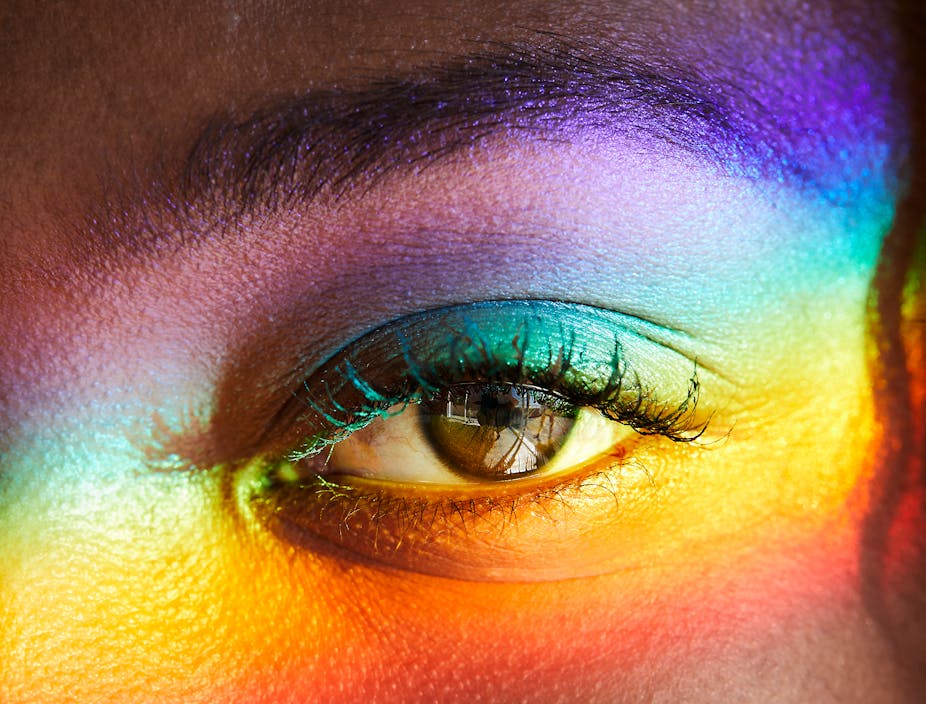Curious Kids is a series for children of all ages, where The Conversation asks experts to answer questions from kids. All questions are welcome: find out how to enter at the bottom of this article.
How can we be sure that people see the same colour when they look at something? – Henrietta, age 12, Market Harborough, UK
Thanks Henrietta, your question is a good one, and in fact we can’t be so sure that we do all see the same colours. What colours we see depends not just on how things are in the world around us, but also on what happens in our eyes and our brains.
If you and I look at the leaves of a tree, we might both say that they are “green”. But could it be that you see them as green, while I see them as a colour closer to your brown, or maybe even your purple.
Let me explain. The eyes sense light, and we can think of light as being made up of many waves of different lengths. The shortest wavelengths we can see give us the colour violet, while the longest wavelengths give us red.
There are also lots of wavelengths we can’t see, which create colours we can’t even imagine.

Most of the objects we can see around us don’t make light themselves. Instead, light from the sun, the moon or man-made lamps hits them.
Depending on the object, some wavelengths of light will bounce off, while others will be taken in. When we look at an object, our eyes sense the waves of light that have bounced off it.
This all happens very fast, because light moves extremely quickly – almost 300m metres per second, in fact.
You might think that if the colour of an object is decided by the wavelength of light that bounces off it, everyone would see colours the same. But there’s more going on inside the human body, which affects how people see colour.
Cells and cones
The backs of our eyes are covered with a thin layer of cells, which respond to light. Cells are the building blocks of all life. The cells in the back of our eyes, which help us to see colour, are called cones.
Most people have three kinds of cones in their eyes – S, M and L cones – and each of these only senses light waves of a certain length.
When a long wave hits an L cone, it seems to fit into it, like a key in a lock. The cone then shouts out to its neighbours that it has caught some light, so we say that it’s active.

The L cones only care about long light waves, so they won’t catch any short or medium ones: those go to the S and M cones.
When light hits the S cones and they become active, we call that “blue”; when it’s the M cones, we see “green”; and when it’s the L cones, we see “red”.
Some people have more or fewer than three kinds of cone cells in their eyes. Some people – we can’t be sure exactly how many – have four kinds of cones. But for those of us with three, we can’t really imagine how they might see the world.

Many people only have two kinds of cones – these people are often called “colourblind”. Colourblind people don’t see things in black and white; they just have trouble telling the difference between red and green – both could look sort of brown to them. Dogs also only have two kinds of cones, so they probably also have trouble seeing differences between red and green. But some animals have amazing colour vision.
For example, bees can see shorter wavelengths than humans, and use this ability to find the sweet nectar in flowers. The Mimulus flower petals have a dark-coloured “path” to guide bees down to the nectar, which humans cannot see at all.

Seeing with your brain
But it’s not just our eyes that see – it’s our brains. We say we see different colours because of how our brains learn to link the signals they get from the eyes with the names of different colours. When a baby points at a ball and her father asks, “would you like to play with that green ball?”, she learns to associate the colour she’s seeing with the word “green”, and she will soon call things of a similar colour “green” as well.
Many other things can affect how your brain sees colour, including the season, what you looked at before or the position of your body. Try this experiment to see for yourself:
Lie down on your left side for five minutes, with your eyes shut. Now, close your left eye and open your right eye. Then switch eyes. Do things look different when you’re using different eyes?
When you laid on your side, more blood went to the lower (left) part of your head and body, and this makes the colours you see with each eye look different.
Can we be sure that people see the same colour when they look at something? Not at all - while the cones in our eyes suggest we’re seeing something similar it’s likely that we all see just a tiny bit differently.
Hello, curious kids! Have you got a question you’d like an expert to answer? Ask an adult to send your question to us. You can:
* Email your question to curiouskids@theconversation.com
* Tell us on Twitter by tagging @ConversationUK with the hashtag #curiouskids, or
* Message us on Facebook.

Please tell us your name, age and which town or city you live in. You can send an audio recording of your question too, if you want. Send as many questions as you like! We won’t be able to answer every question, but we will do our best.
More Curious Kids articles, written by academic experts:

